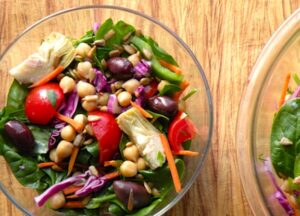Simple, natural foods produce the glow of good health as evidenced by radiant skin, a strong, flexible body, and a well-functioning immune system. The state of our bodies is genetically destined to some degree. The rest we construct ourselves, largely from the food we eat. Experts and mock experts debate ceaselessly about how we ought to feed ourselves, and diets go in and out of style more rapidly than hemlines or hairdos.
Yoga philosophy, however, which has always had a lot to say about living physical life in accordance with spiritual laws, hasn’t changed its basic dietary recommendation for over two thousand years. It is: Choose pure foods, and enjoy them in moderate amounts.
The yogis classify foods, and everything else for that matter, in groups called gunas, the basic characteristics of creation. The three gunas are tamasic, the quality of gravity; rajasic, the quality of motion; and sattvic, the quality of light.
Tamasic foods are those considered lifeless. They include anything stale or tasteless; leftovers of more than twenty-four hours and anything that’s been in the freezer for a long time; also aged cheese, alcoholic beverages, deep-fried fare, and all highly processed foods with chemical additives. The teaching is that too many of these promote lethargy and fatigue and lessen our sensitivity to beauty and virtue. Rajasic foods— meat, eggs, refined sugar and soft drinks, stimulants like coffee, and dishes with fiery spices and lots of salt— set our body rhythms at full speed ahead. When taken in excess, these can add to our stress levels and make us driven and high-strung.
Balancing these two extremes are the simple, natural sattvic foods, including fresh fruits, raw or lightly cooked vegetables, wholes grains and brown breads, beans, nuts, honey, and milk from healthy cows. It is believed that eating predominantly sattvic foods is healthy and calming, sharpens the mind, supports spiritual growth, and keeps the body’s channels clean. This produces the glow of good health as evidenced by radiant skin, a strong, flexile body, and a well-functioning immune system. The ancient Indians had a name for this glow, ojas, which they defined as the physiologic expression of bliss: a nonstop, underlying happiness that persists even through trying times. Foods said to be especially ojas producing include:
Barley: You can buy whole barley at a natural food store and prepare it as a hot cereal or use it in soup to replace rice or noodles;
Basmati rice: An aromatic, nutty- flavored rice available in both brown and white varieties at most supermarkets;
Mung beans: The bean sprouts used in Chinese cooking are usually mung bean sprouts; you can also buy quick-cooking mung dhal, split mung beans, at Indian markets and some grocery stores;
Sesame seeds: Toss a tablespoon into a smoothie or sprinkle some on a salad; discover tahini (sesame butter) and halvah (sesame candy) at health food stores and in the foreign foods aisle of the supermarket;
Blanched almonds: Buy them already blanched (they’re sold inexpensively in the bulk barrels at many natural food stores), or buy plain raw almonds, cover them with boiling water, let them sit a couple of minutes, and pop off the skins yourself;
Fresh fruits, particularly dates, figs, and oranges: Buy organically grown fruit whenever you can; grapes, peaches, apples, pears, and berries tend to be heavily sprayed and should be organic if possible. When you’re buying dried fruit like figs, look for the kind that have no sulphur added. Because dried fruit is very sweet, you may want to soak it in pure water for a few hours so it more nearly resembles its fresh state when you eat it.
Good food choices are half of the yogic dietary equation. The other is moderation. A commentary on the Bhagavad Gita reads, “Even nectar becomes poison when eaten too much.” Modern science concurs, noting that a common theme among people who live healthfully into their nineties and beyond is a lifetime of moderate eating. Moderation is actually the flip side of dieting, that is, imposed deprivation. It is instead choosing foods that are so delicious, so delightful to look at and to smell, and so satisfying to the appetite and to the body’s trillions of nutrition-seeking cells that the need to overeat can be arrested at its source.
An additional way to guard against eating to excess is to give your body digestion time between meals. Nonstop eating causes more than weight gain: it causes energy loss. Digesting food is an energy-intensive process. Piling more food on top of what hasn’t been digested yet hinders the process, causing fatigue. Some people have medical conditions that require them to eat frequently, but the rest of us would do well to take the yogic path and stick with three meals a day. “Nothing in between?” I asked my first yoga teacher, somewhat shocked, when she suggested this. “Living in between,” she told me.
Excerpted from Lit from Within* by Victoria Moran. Victoria Moran is a life coach and the author of several bestselling books, including The Love-Powered Diet, Creating a Charmed Life,* and others. Visit her at VictoriaMoran.com.
- For lots more features on healthy lifestyle, explore VegKitchen’s Healthy Vegan Kitchen page.
*This post contains affiliate links. If the product is purchased by linking through this review, VegKitchen receives a modest commission, which helps maintain our site and helps it to continue growing!






Comments
No Comments